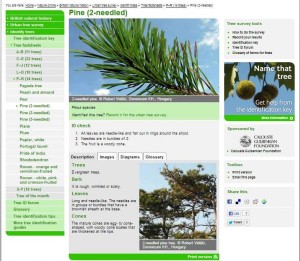In Dr M’s survey of online plant ID aids he has already taken a look at the SAPS key to trees and shrubs from Cambridge University.
Here Dr M has a look at an interactive key to 88 species of trees and shrubs from the Natural History Museum key to Nature project.
The NHM key is part of the NHM Citizen Science initiative and created for the Urban Tree Survey which started in 2010 and aims to collect information about the trees growing in towns and cites across the UK. The survey is focusing on the least known trees – those in private urban gardens.
The key includes common broad leaved trees as well as conifers. There are two versions the key:
1. The accessible version, at each step you select the statement that best describes the tree you are looking at. When you reach an identification, you can choose to see more detail about that particular tree.
2. The interactive key (featured image) is a series of question-and-answer steps leading to an identity or name. You select the statement that best describes the tree you are looking at. Remember the image illustrates the statement, not your tree. If you need to, you can go back to an earlier step by selecting it. You the continue until you reach an identification
The gallery shows the steps to keying out one the 3 native conifers in the UK, Pinus sylvestris (Scots Pine) using the interactive key
- Step 1
- Step 2
- Step 3
- Step 4
- Step 5
- Step 6 – Pinus spp!
Note the key ends up with 2-needle pines rather than Scot’s Pine per se and you would need to refer to other books to verify this.
Dr M’s verdict on the NHM key to trees and shrubs: Lots of helpful information and illustrations here. As this key is part of the urban tree project there is a good focus and probably lots of improvements due to field testing by non-experts. There are two keys (accessible and interactive) so you can try them both and use the one you feel most comfortable with. Good illustrations and tree fact sheets mean you can check details of a named tree as well as using the key. Puts some species into groups, e.g. 2-leaved Pines, Service trees (Sorbus) etc, so for these you can’t get to the exact species and have to check other resources, but that’s OK as long as you do it!









